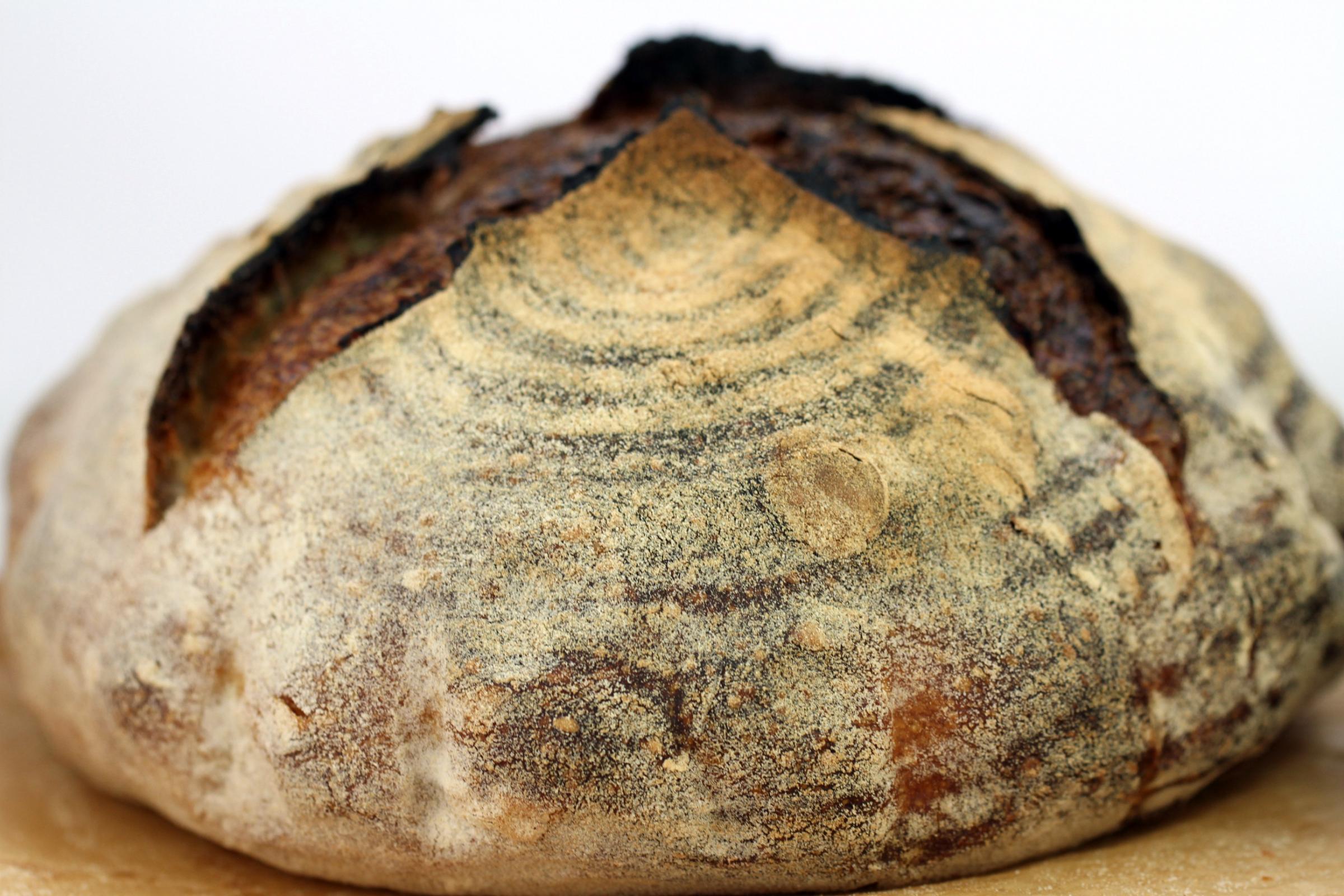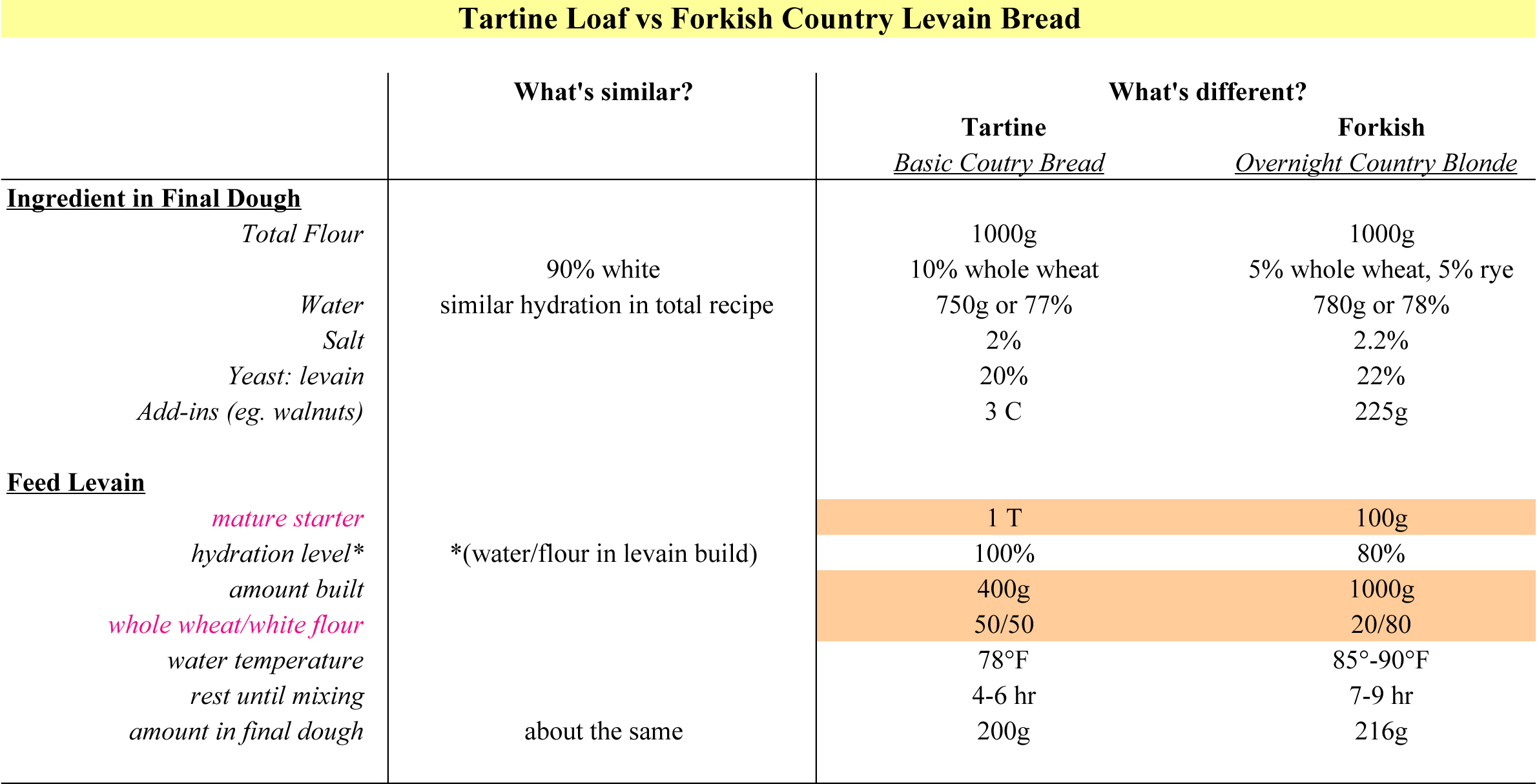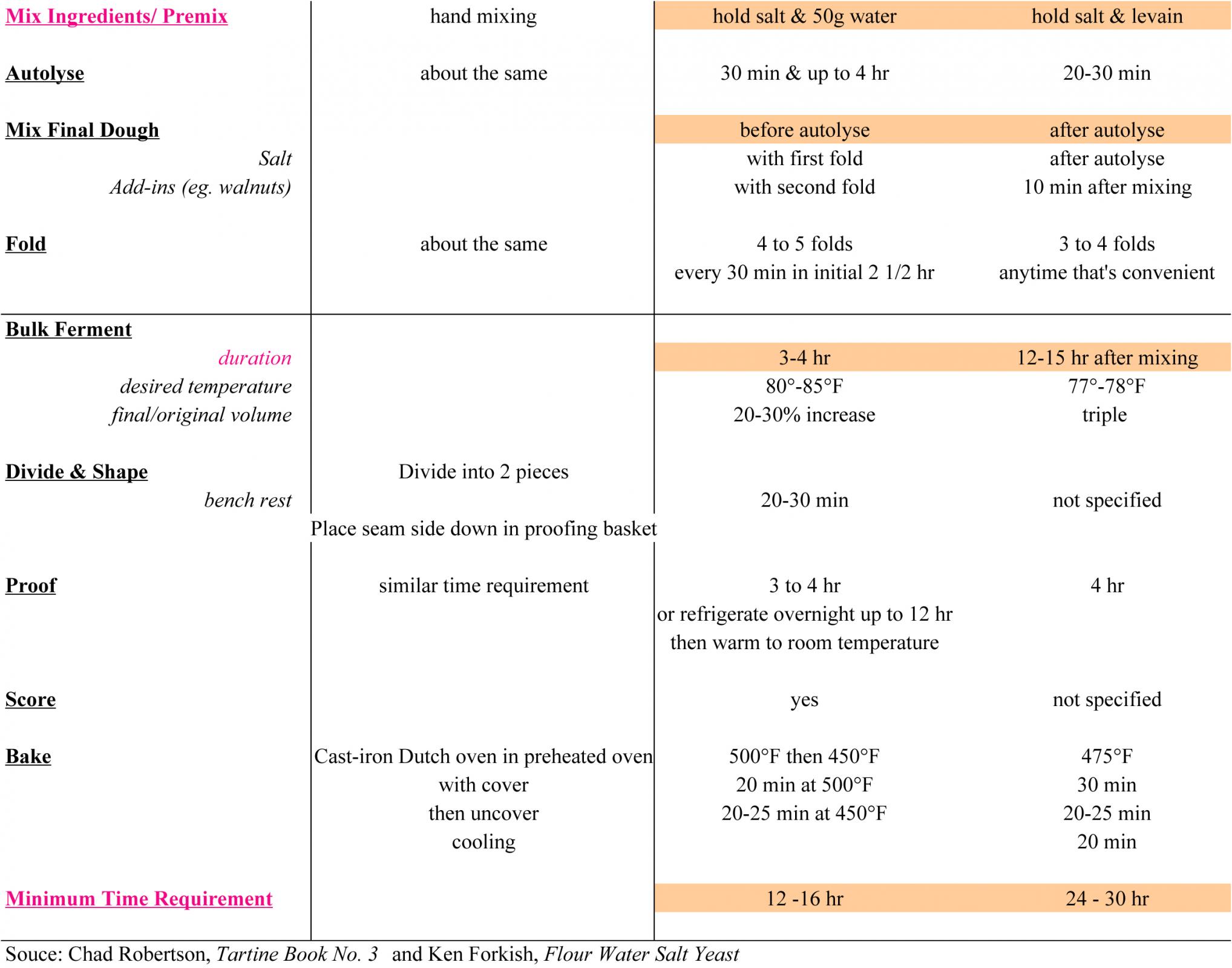This is the first time I bake any Ken Forkish’s bread. This is the first time I post on the Fresh Loaf blog, although I’ve read and learnt so much from a lot of the active participants here. Rightly or wrongly, I feel I can’t be a complete bread baker, among other things, if I’ve never tried Forkish’s recipes. I started baking a lot of Chad Robertson’s breads after I read his two books, Tartine Bread and Tartine Book No.3, a year ago.

At the same time, I got a new heavy-duty dual-fuel range that is wide enough to bake full size baguettes. Most of these breads were posted on my blog (http://flourishen.blogspot.com). Overnight country blonde was the first I baked from Forkish’s Flour Water Salt Yeast. I figure the best start is to bake something closest to what I am most familiar with,which is the Tartine basic country bread. I followed the overnight country blonde recipe to a T, except for the part that you are not supposed to score the dough, which I did.
There are a lot of similarities between Forkish and Tartine’s approach, but there are enough differences, e.g. in building the levain, the fermentation process and baking temperature. To keep track of what I was doing and understanding the unique approaches, I put all the steps side by side in a spreadsheet.
Here are the comparisons and my takeaway from having baked the overnight country blonde and many variations of the Tartine country bread.


http://flourishen.blogspot.com/2015/05/overnight-country-blonde-levain-bread.html
- Both Tartine basic country bread (Tartine) and Forkish country blonde (Forkish) are excellent. It'd be akin to hairsplitting if I say that one is better than the other.
- Tartine and Forkish have similar hydration level of roughly 77-78% using 90% white flour in the total flour amount.
- While Tartine uses one tablespoon of starter to build 400g of levain, Forkish uses 100g to build 1000g, which results in a greater amount of levain being discarded.
- Salt and small amount of water are added to the Tartine dough (levain and all) after 30 minutes of resting period, at which point the dough is relaxed, cohesive and easy to work with. Meanwhile salt and all of the 216g of levain are incorporated into the autolyse mixture to make the final Forkish dough, which I find much wetter and stickier to handle.
- Bulk fermentation is 3 to 4-hr at 80°-85°F for Tartine and 12 to 15-hr at 77°-78°F temperature for Forkish. The longer fermentation of Forkish dough necessitates baking the bread the next day, spanning a two-day process from the time you mix the dough.
- The longer bulk fermentation of the Forkish dough imparts a much sourer note in the finished loaf.
- The higher oven temperature in baking the Tartine dough often results in a thicker and burnished crust, especially on the bottom.
Now I need to integrate these approaches in order to make better breads in my own kitchen setting. I want to move away from baking from recipes and develop a more intuitive feel for my breads. Any suggestions from someone who has gone down this path before?
- Flour.ish.en's Blog
- Log in or register to post comments
Welcome to the active participant part of this forum.
Well documented and written up. Handsome loaves too. There is a multitude of folks out here who can help and advise in your quest for developing your own recipes. But I'll mention this one thing, something that has bugged a lot of TFL's constituency. That is what seems to be the wanton discarding of the Forkish "spent fuel". Rather than discard it, why not reserve it in the refrigerator and use it the next time around. These starters are quite resilient and when put to sleep in the fridge, will have a lot of strength for your next bake. Saves you a lot of refresh activity and flour.
Good tips and thanks, Alfanso! Finding ways to reserve the starter definitely is an option. How realistic it is to keep a 50/50 (AP/wheat flour) and an 80/20 starter is another concern. More to think about!
Really nice crumb. You're write up is very good too. For your 1st time here and with this recipe what a great success.
I like to build up to the required amount rather than building loads and only using a small amount. But I like Alfanso's idea too. Good idea to just refrigerate and use when ready. I used to think a starter had to be freshly fed and peaked to use but not necessarily so. Feeding and using at optimum time well is... "optimum". However you can still use a starter that has matured and been stored in the fridge for a few days. We build preferments (or feed our starter) for a couple of reasons:
1. To build up enough if you only keep a small amount.
2. To build to a specified flour + hydration.
But if you have built a lot of starter (or preferment) then no need to chuck it just use the rest when ready to bake again. You might also find it'll produce a more tangy bread too.
Don't forget that a freshly fed and matured starter will make your dough ferment quicker then one pulled from the fridge after a few days.
for that idea. dabrownman is the one who pushed me to not discard the extra levain, but rather retard and reuse it.
I'm still just groping my way through the whole levain/SD/culture/starter/you name it world (ugh, not a pretty visual!). But I'm finding great success in the refreshes from using this still potent discard. My second build seems to take no more than 2 hours to double, the third build in just under two hours. But I do have a warm kitchen. Once you get it down, as I'm first starting to now, it's "easy peasy" as Mike Ehrmantraut says.
It was Dabrownman and Drogon who taught me that one doesn't necessarily have to freshly feed a starter and allow it to peak in order to use in a recipe.
o you do refresh it still but a second refreshment takes quicker. I seem to understand that within 3 days or so, and as long as you have enough, it can go straight in. I "believe" (hope I've understood this correctly) that Dabrownman can refresh his starter, put it in the fridge, and use weeks later for a really sour bread. One just has to take into consideration that fermentation time of the dough will be longer so when following a recipe take this into account.
Thanks for your comment. When to feed and use the starter and how much to use is part and parcel of a perfect loaf. At least at this stage, I think I know my starter well enough. A friend of mine keeps asking me for starter. She said she messed up, don't really understand how. I just have to find more friends who need constant supply of the starter culture.
Everyone here has their own way of feeding and maintaining a starter. Here is the way I do it with no discard at all.
I keep about 90-150g in the fridge at any one time.
Each time I wish to bake i'll take a little off and build pre-ferments.
When my starter in the fridge runs low i'll take it out, feed it, allow it to feed by half then return to the fridge.
And the process starts again.
If I try a recipe which suggests building a huge amount but only uses little (eg Forkish) then i'll ignore that and build up to the correct amount with the right flour and hydration.
If you find yourself with a lot of starter then give to friends, bake pancakes with it, add too cakes, make waffles...
Practical ideas that I can really take them to the bank. I like the no discard part. Thanks! Does it matter how long the starter sits in the fridge? What's the upper time limit for a "functional" starter to stay in the fridge. I have to ask someone to feed my starter when I'm away. May be that's not necessary! Is it true that it's better to feed the starter regularly?
They can go for weeks between feeds in the fridge. And never develops any hooch. My other starter which is 6% whole rye, 24% whole wheat and 70% bread flour needs more TLC and does develop hooch if kept too long this way.
But they always spring to life when topped up. And my preferments work well.
If you return it to the fridge when it's not completely fed and peaked then there's some food reserves it can munch on slowly helping to extend the length between feeds.
But my whole rye starter is 15 months old and the other one is over 5 years. So well established. What you can do is build up to this. Perhaps feeding atleast once a week come what may and then slowly increase till you feed when necessary. I never let them run down below one tablespoon.
You might wish to do two builds or more for your preferments to ensure strength but I've never had a problem.
When I go away i'll feed just before and when returning to the fridge i'll take a little off to put in the freezer just in case as a back up.
I ain't (amn't, isn't, nottn't?) no starter expert, still rather early in my starter start, so there is a world of wiser brains out there on the subject, but as long as you are asking...
If you refresh to make enough stiff starter to last a while (your mileage may vary), it can live undisturbed in the back of your fridge for months at a clip, just a-snoozin' along. My current starter probably hasn't been refreshed for at last 2.5 or 3 months, and it is ready to be called to duty at the drop of a recipe hat.
Here's Ol' Rufus as of recently (I really don't label inanimate objects with names, but since others on TFL do, I'll make believe for this one time). Ol' Ruf lives in a tupperware container with a sheet of plastic-crap (thanks David) tightly pressed on his surface. He almost never weeps any excess liquid nor hootch, and no wet dog or off smells either).
As far as the discard jazz goes - I have this unfounded but sneaking suspicion that building a stronger levain can result from doing something similar to what I outlined elsewhere recently, and it goes something like this:
I am trying out a 3 stage build, but in a different fashion than yours, and it worked great for these two bakes.
The levain just seems to turn into the Incredible Hulk in a short time when done this way.
And now that I have a healthy amount of this still potent discard leftover, for my next trick I MAY completely ignore step 1 above and just concentrate on build steps 2 and 3. But this time, Ill work with almost all discard and very little fresh flour and water. If it works, then I'm a genius and if it doesn't then I still have plenty of discard left over to re-employ otherwise for another build process.
Either way, I'll learn something or other and, in a way, isn't that what it and TFL is all about (other than the bread, darn it!)
Wow, the amount of information comes faster than I can absorb. They are all good! I'm glad I posted here.The freezer starter as a backup is something I would start doing. Anything you've put in so much time and energy is worth insuring. Do you ever go beyond stage 3 in roughly one working day in activating the starter? I guess it won't hurt if you feed it one more time just to ensure that the starter is young and the timeline fits.
I sometimes think that the differences between Tartine and Forkish are only there so Chad can't sue Ken :-) Both methods make nearly the same bread. A slightly sour near white SFSD style bread. it is nothing ,kike the the SFSD of the late 60's and early 70's but you can easily maintain, build levain and do various retards to that give you a more old time SFSD taste.
I hate to throw any food away and everything I can not to do so. So much work and effort, not to mention money, goes into making the best and freshest food we eat around here and I'm not tossing any if it if I can help it,
The other problem I have.with tossing any part of starter and levain builds is that I find by doing so just makes the end result less flavorful rather than more so. Time is the variable that can make the big difference in flavor. When you toss half the starter or levain and give it another feeding, you are essentially whacking it back 4 hours or more on the flavor train and telling it to start over. Then, once it gets back to where it was, you are going to halt its progress again and put your flavor profile back 8 hours or more the next time.
If you are trying to make a Tartine or Forkish SFSD style bread that is slightly sour and mildly flavorful, you have to follow the starter and levain builds that make the bread this way. Let's be honest here. Most people, just like always throughout history, don't like sour bread and why so little of it is made - and why when it is made, it is made to have the least sour possible. Chad and Ken have to sell their bread to make a living and they know what their customers like and want. I call it white wine. But I think people will come over to more red wine SD eventually.
Red wine outsells white 55% to 45% in the USA. The reasons are many but the two biggest ones are that red wines have much more complexity of flavor and two they are seen as being healthier with red wines supposed being better for you. Still, even with these benefit and attributes they barely put sell white.
The same can be said for SD. A Tartine or Forkish near white slightly sour bread just can't hold a candle flavor or health wise to other darker more whole and sprouted grain breads but the white still hangs in there sales wise. I predict that times are a changing and that peoples tastes and choices SD bread wise are changing with it.
I think people will eventually move over to the kind of breads that I and Josey Baker make and why Chad came out with Tartine 3. There is so much more than SFSD near white bread out there and experimenting with starters and levain builds is one way to get to where more and more folks will want to go - eventually.
Just look at what is happening in France today where commercial yeast, inexpensive and low quality flour baguettes were the preferred 'Wonder Bread of the Masses' for just about forever. Not so much any more though. This kind of French bread has been and is on a long decline in popularity for good reason. There are better choices flavor wise and health wise out there today. Those of us who have made SJSD baguettes know what tastes and lasts longer and are better for you too.
In my book the best tasting SD white bread that is better for you, is one that is 40 - 50% whole sprouted multi-grain, say rye, spelt, Kamut and spelt in equal amounts, mixed with some AP and bread Flour ,half and half, with some toasted ground flax and sesame seeds, or some Toadies, or better yet a baked scald with some red and white malts, Toadies and ground flax, poppy and sesame seeds in it. Use about 12% whole multi-grain levain that was built in 3 stages from a small amount of 8 week retarded whole rye stiff starter and then retard the built levain for week before adding it to an 2 hour autolyse. mix. Then retard for and unshaped bulk ferment or shaped final proof for at least 12 hours. Now this is a long, involved process not for the fast and furious but, it is easy and most of the time is spent waiting around doing nothing:-) The results can be like nothing you or anyone else has ever tasted before.
Compare the taste and health benefits of this whit bread to Forkish or Tartine SFSD breads and you be the judge. You either, like white wine or red wine when it comes to bread - even though this one is is a rose rather than a real red. Thankfully, we can craft and enjoy a bread that we each like to make and eat just like we can craft out own beer, cheese, other fermented foods. charcuterie and smoked meats.
Happy SD baking your way - it's all good....
Thanks for your insights into the history and current trend in SD baking. I am with you on going beyond the basic country breads. The real joy for me had been baking those sprouted and porridge breads. The complexity of flavor and healthfulness of these breads are like no others.
Now it is ruined with all that healthy great tasting stuff in there:-) I made some Greek yogurt last night while I slept, a lot like SD bread making, and used some of the whey to marinate tonight's dinner chicken breasts. My wife wanted to know if I had gone nuts and I said - i sure have! Very tasty!
Happy baking